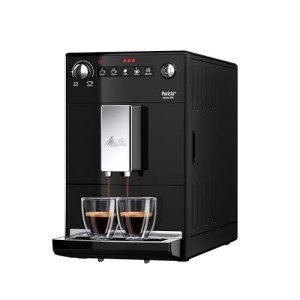The Art of Italian Espresso Machines: A Brewed Tradition
Italian espresso machines are not simply devices; they are an important part of Italy's abundant coffee culture, representing a blend of artistry, engineering, and style. Coffee aficionados all over the world recognize the significance of high-quality espresso, a staple of Italian life and cuisine. This short article explores the history, mechanics, types, and factors to think about when buying an Italian espresso machine, reflecting the depth of this beloved beverage and its brewing techniques.
History of Espresso Machines
The espresso machine's advancement go back to the early 20th century in Italy, where coffee was not simply a drink but an important social ritual. The preliminary efforts to brew espresso begun with basic, stove-top models, slowly progressing into complicated machines that might replicate the perfect brew.
- 1901-- The First Espresso Machine: The first steam-powered espresso machine, referred to as the "Ideale," was developed by Luigi Bezzera. This machinery marked a turning point in espresso brewing.
- 1938-- The Lever Machine: The intro of the lever machine made it simpler to control the pressure utilized in espresso extraction, enhancing flavor consistency.
- 1947-- The Automatic Machine: Reaching more consumers, Gaggia released the first automatic espresso machine, more promoting espresso bars.
- 2007-- The Digital Age: Technological advancements caused the birth of totally programmable machines, allowing users to tailor their developing settings to achieve a customized coffee experience.
Key Features of Italian Espresso Machines
Italian espresso machines embody precision, workmanship, and innovation. Here are some crucial components that highlight their significance:
| Feature | Description |
|---|---|
| Boiler Type | Figures out how heat is created and kept. Common types include single boiler, dual boiler, and heat exchanger. |
| Group Heads | Where the coffee is brewed; commercial machines frequently have numerous group heads for performance. |
| Pressure Control | Essential for accomplishing the ideal espresso; most machines operate at 9 bars of pressure. |
| Frothing Capabilities | The steam wand enables milk frothing, necessary for beverages like cappuccino and latte. |
| Develop Quality | The materials utilized (stainless-steel, brass, and so on) influence toughness and heat retention. |
Types of Italian Espresso Machines
Picking the ideal machine depends upon user choices, budget, and meant use. Below are the main kinds of Italian espresso machines:
Manual Espresso Machines
- Pros: Offer full control over the developing process, enabling an individualized touch.
- Cons: Require skill and practice, can be labor-intensive.
Semi-Automatic Machines
- Pros: Provide a balance between automatic and manual processes; users manage water flow.
- Cons: Can have a steeper learning curve than fully automatic machines.
Completely Automatic Machines
- Pros: Simplify the developing process with push-button operations; suitable for newbies.
- Cons: May compromise a few of the nuances of manual brewing.
Super-Automatic Machines
- Pros: Grind, tamp, brew, and froth immediately; practical for busy lifestyles.
- Cons: Less control over the developing variables, capacity for a less authentic espresso experience.
Purchasing Guide: Factors to Consider
Selecting the perfect Italian espresso machine can be challenging, however thinking about the following elements can simplify the decision-making process:
- Budget: Italian espresso machines vary from affordable to high-end designs, so set a budget upfront.
- Usage Frequency: Evaluate how often you will use the machine; day-to-day users might desire a more resilient choice.
- Space: Measure your kitchen area or counter area; some machines can be large and require enough clearance.
- Maintenance: Consider ease of cleansing; machines with detachable parts or integrated cleansing functions may lower maintenance.
- User Skill Level: Beginners might choose fully or semi-automatic machines, while experienced baristas can manage manual machines.
- Brand name Reputation: Research brand names known for quality, such as Breville, Gaggia, and La Marzocco.
Popular Italian Espresso Machine Brands
Italian workmanship is renowned for producing a few of the best espresso machines worldwide. Here are top brand names worth thinking about:
- Gaggia: Known for its home espresso machines and affordability.
- La Marzocco: A superior brand name known for its commercial-grade machines and ingenious innovation.
- Rancilio: Renowned for its durable build and professional-quality machines ideal for home and commercial use.
- Sage/Breville: Offers advanced functions and user-friendly styles, best for both amateurs and lovers.
Frequently asked questions
What is the distinction in between espresso and routine coffee?
Espresso is a concentrated coffee brewed by forcing hot water through finely-ground coffee under pressure. It has a thicker consistency, richer flavor, and higher caffeine concentration than regular coffee.
Can I make milk-based drinks with an espresso machine?
Yes, many Italian espresso machines include a steam wand to froth milk for drinks like cappuccinos, lattes, and macchiatos.
How frequently should I clean my espresso machine?
Routine maintenance is essential. Normally, Buy Espresso Online is suggested every couple of weeks, while descaling ought to be done every 1 to 3 months, depending on water firmness.
What is the perfect pressure for developing espresso?
The perfect pressure for developing espresso is around 9 bars. This pressure makes sure the optimum extraction of flavors from the coffee grounds.
Are more costly machines worth the financial investment?
Higher-end machines often use much better materials and innovation, supplying improved sturdiness and more constant outcomes. For severe coffee enthusiasts, purchasing an excellent machine can elevate the espresso experience considerably.
Italian espresso machines are much more than mere brewing devices; they are an event of a cultural tradition that has affected coffee usage worldwide. With various models offered to fit any user's needs-- ranging from beginners to skilled baristas-- there is an Italian espresso machine completely matched for everybody. As you start your espresso journey, comprehending the history, mechanics, and choices will enrich your experience and appreciation for this time-honored drink. Whether you look for to recreate a café atmosphere in your home or improve your developing technique, these machines are capable of providing memorable cups of espresso adorned with the rich history of Italian coffee culture.

